Evaluating Performance Management: A Comparative Essay on Approaches
VerifiedAdded on 2023/06/07
|8
|1698
|98
Essay
AI Summary
This essay analyzes and compares two articles on performance management, exploring the similarities and differences in the authors' claims regarding performance management effectiveness. It discusses various approaches like balanced scorecards and multisource feedback, along with their advantages and disadvantages, supported by additional literature. The essay emphasizes the role of motivation, employee engagement, and human resource management in improving organizational performance. It concludes that performance appraisal and motivation are crucial for enhancing organizational productivity, suggesting that effective remuneration and performance appraisals are essential for managing and improving overall performance.
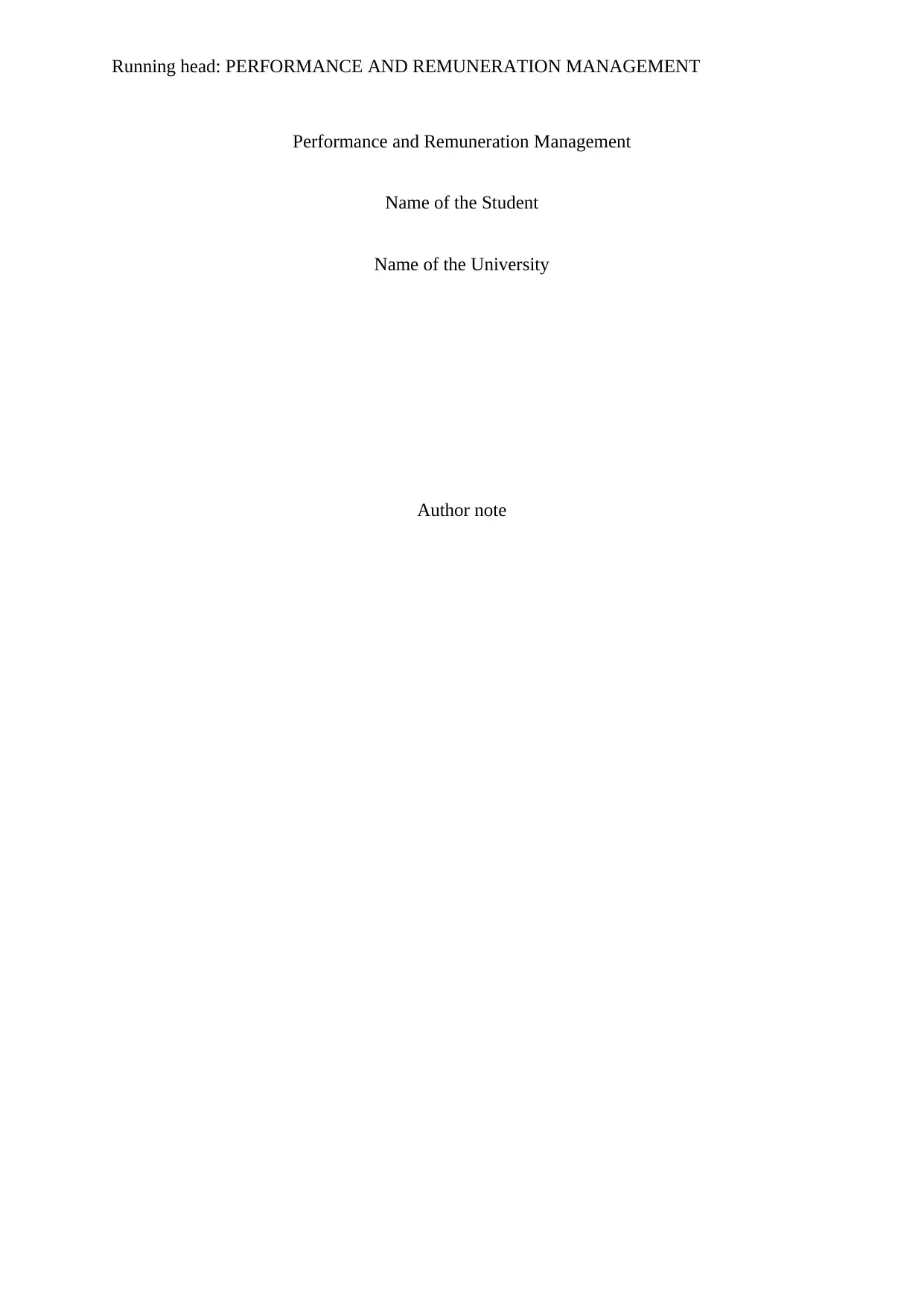
Running head: PERFORMANCE AND REMUNERATION MANAGEMENT
Performance and Remuneration Management
Name of the Student
Name of the University
Author note
Performance and Remuneration Management
Name of the Student
Name of the University
Author note
Paraphrase This Document
Need a fresh take? Get an instant paraphrase of this document with our AI Paraphraser
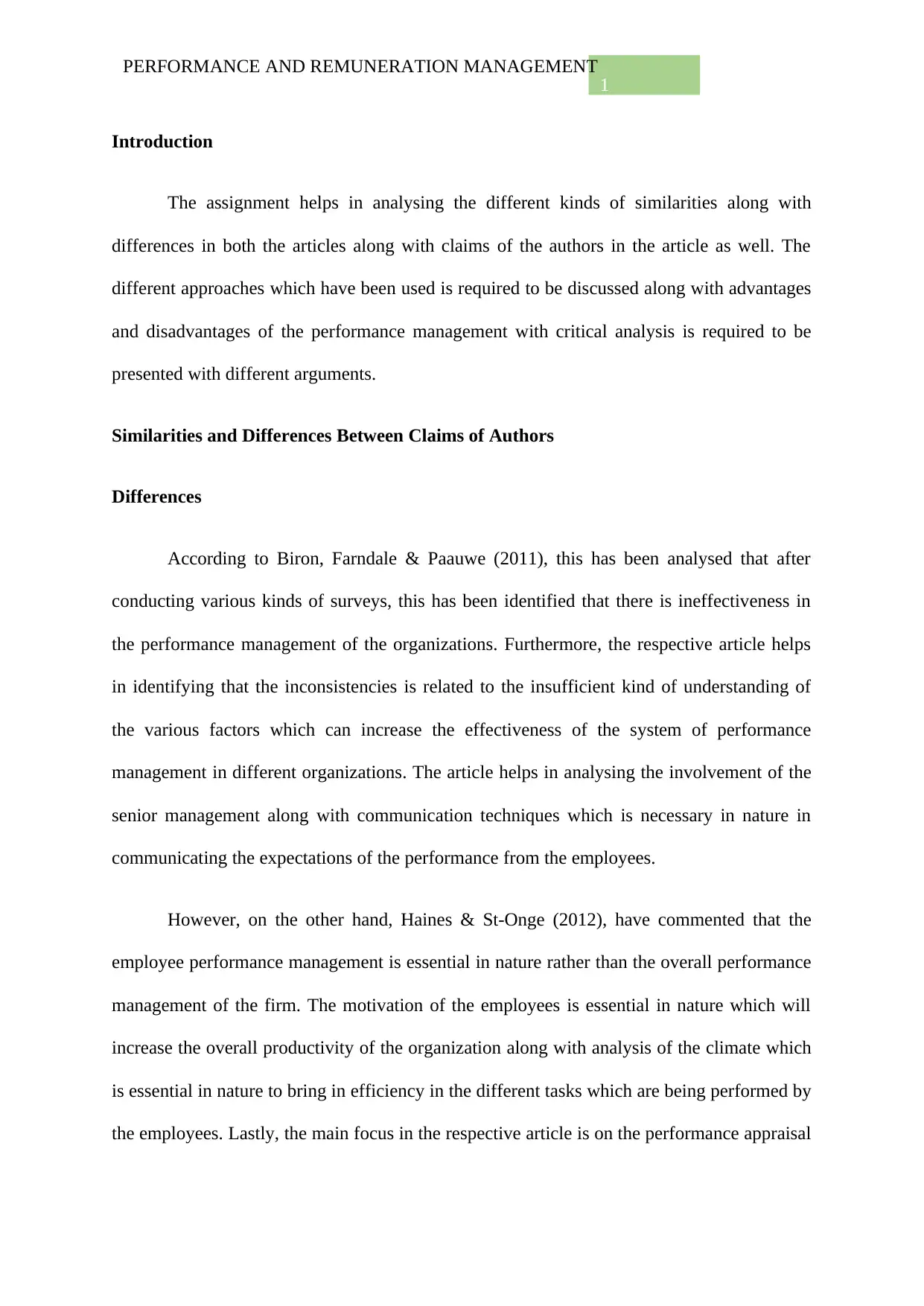
1
PERFORMANCE AND REMUNERATION MANAGEMENT
Introduction
The assignment helps in analysing the different kinds of similarities along with
differences in both the articles along with claims of the authors in the article as well. The
different approaches which have been used is required to be discussed along with advantages
and disadvantages of the performance management with critical analysis is required to be
presented with different arguments.
Similarities and Differences Between Claims of Authors
Differences
According to Biron, Farndale & Paauwe (2011), this has been analysed that after
conducting various kinds of surveys, this has been identified that there is ineffectiveness in
the performance management of the organizations. Furthermore, the respective article helps
in identifying that the inconsistencies is related to the insufficient kind of understanding of
the various factors which can increase the effectiveness of the system of performance
management in different organizations. The article helps in analysing the involvement of the
senior management along with communication techniques which is necessary in nature in
communicating the expectations of the performance from the employees.
However, on the other hand, Haines & St-Onge (2012), have commented that the
employee performance management is essential in nature rather than the overall performance
management of the firm. The motivation of the employees is essential in nature which will
increase the overall productivity of the organization along with analysis of the climate which
is essential in nature to bring in efficiency in the different tasks which are being performed by
the employees. Lastly, the main focus in the respective article is on the performance appraisal
PERFORMANCE AND REMUNERATION MANAGEMENT
Introduction
The assignment helps in analysing the different kinds of similarities along with
differences in both the articles along with claims of the authors in the article as well. The
different approaches which have been used is required to be discussed along with advantages
and disadvantages of the performance management with critical analysis is required to be
presented with different arguments.
Similarities and Differences Between Claims of Authors
Differences
According to Biron, Farndale & Paauwe (2011), this has been analysed that after
conducting various kinds of surveys, this has been identified that there is ineffectiveness in
the performance management of the organizations. Furthermore, the respective article helps
in identifying that the inconsistencies is related to the insufficient kind of understanding of
the various factors which can increase the effectiveness of the system of performance
management in different organizations. The article helps in analysing the involvement of the
senior management along with communication techniques which is necessary in nature in
communicating the expectations of the performance from the employees.
However, on the other hand, Haines & St-Onge (2012), have commented that the
employee performance management is essential in nature rather than the overall performance
management of the firm. The motivation of the employees is essential in nature which will
increase the overall productivity of the organization along with analysis of the climate which
is essential in nature to bring in efficiency in the different tasks which are being performed by
the employees. Lastly, the main focus in the respective article is on the performance appraisal
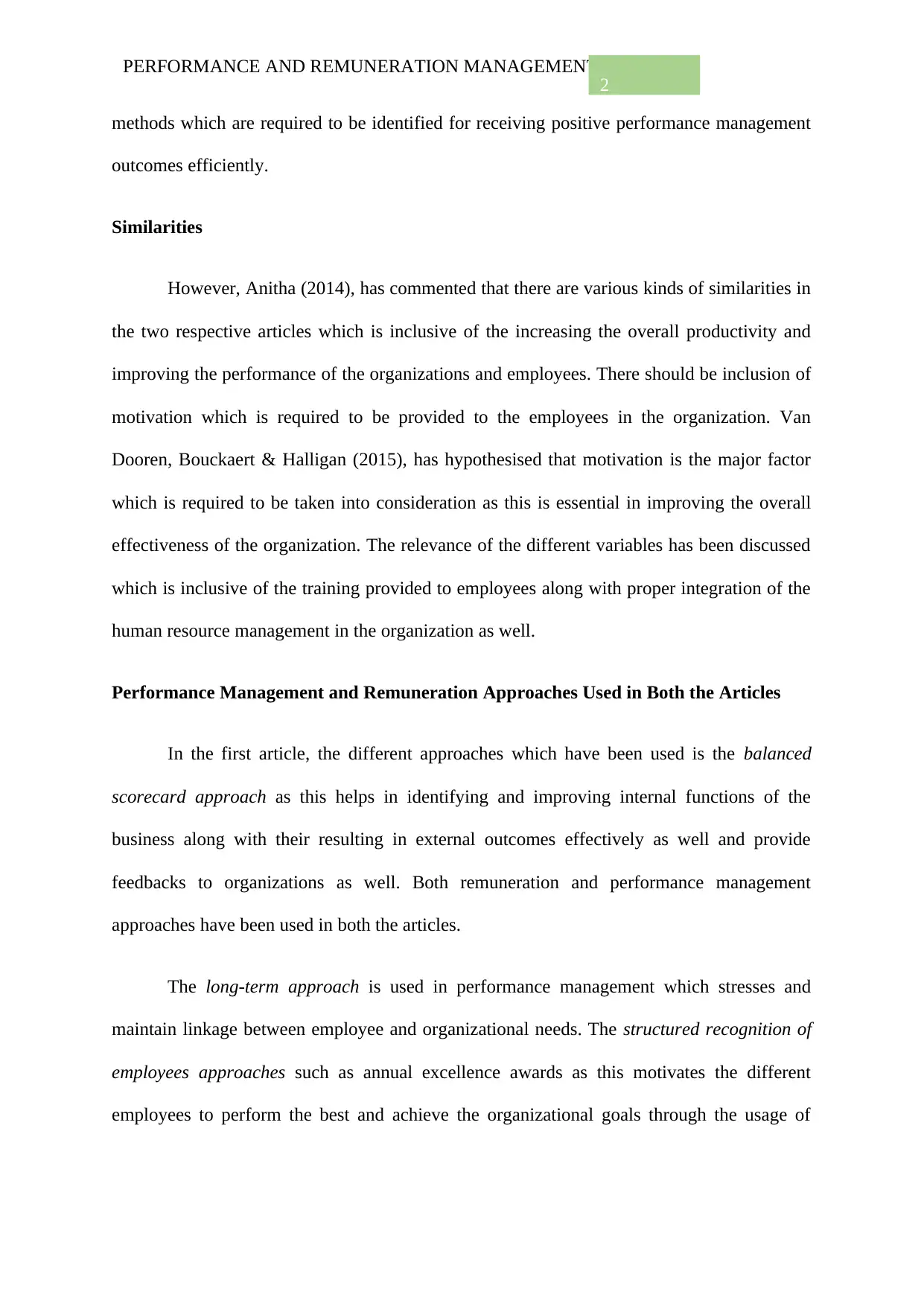
PERFORMANCE AND REMUNERATION MANAGEMENT 2
methods which are required to be identified for receiving positive performance management
outcomes efficiently.
Similarities
However, Anitha (2014), has commented that there are various kinds of similarities in
the two respective articles which is inclusive of the increasing the overall productivity and
improving the performance of the organizations and employees. There should be inclusion of
motivation which is required to be provided to the employees in the organization. Van
Dooren, Bouckaert & Halligan (2015), has hypothesised that motivation is the major factor
which is required to be taken into consideration as this is essential in improving the overall
effectiveness of the organization. The relevance of the different variables has been discussed
which is inclusive of the training provided to employees along with proper integration of the
human resource management in the organization as well.
Performance Management and Remuneration Approaches Used in Both the Articles
In the first article, the different approaches which have been used is the balanced
scorecard approach as this helps in identifying and improving internal functions of the
business along with their resulting in external outcomes effectively as well and provide
feedbacks to organizations as well. Both remuneration and performance management
approaches have been used in both the articles.
The long-term approach is used in performance management which stresses and
maintain linkage between employee and organizational needs. The structured recognition of
employees approaches such as annual excellence awards as this motivates the different
employees to perform the best and achieve the organizational goals through the usage of
methods which are required to be identified for receiving positive performance management
outcomes efficiently.
Similarities
However, Anitha (2014), has commented that there are various kinds of similarities in
the two respective articles which is inclusive of the increasing the overall productivity and
improving the performance of the organizations and employees. There should be inclusion of
motivation which is required to be provided to the employees in the organization. Van
Dooren, Bouckaert & Halligan (2015), has hypothesised that motivation is the major factor
which is required to be taken into consideration as this is essential in improving the overall
effectiveness of the organization. The relevance of the different variables has been discussed
which is inclusive of the training provided to employees along with proper integration of the
human resource management in the organization as well.
Performance Management and Remuneration Approaches Used in Both the Articles
In the first article, the different approaches which have been used is the balanced
scorecard approach as this helps in identifying and improving internal functions of the
business along with their resulting in external outcomes effectively as well and provide
feedbacks to organizations as well. Both remuneration and performance management
approaches have been used in both the articles.
The long-term approach is used in performance management which stresses and
maintain linkage between employee and organizational needs. The structured recognition of
employees approaches such as annual excellence awards as this motivates the different
employees to perform the best and achieve the organizational goals through the usage of
⊘ This is a preview!⊘
Do you want full access?
Subscribe today to unlock all pages.

Trusted by 1+ million students worldwide
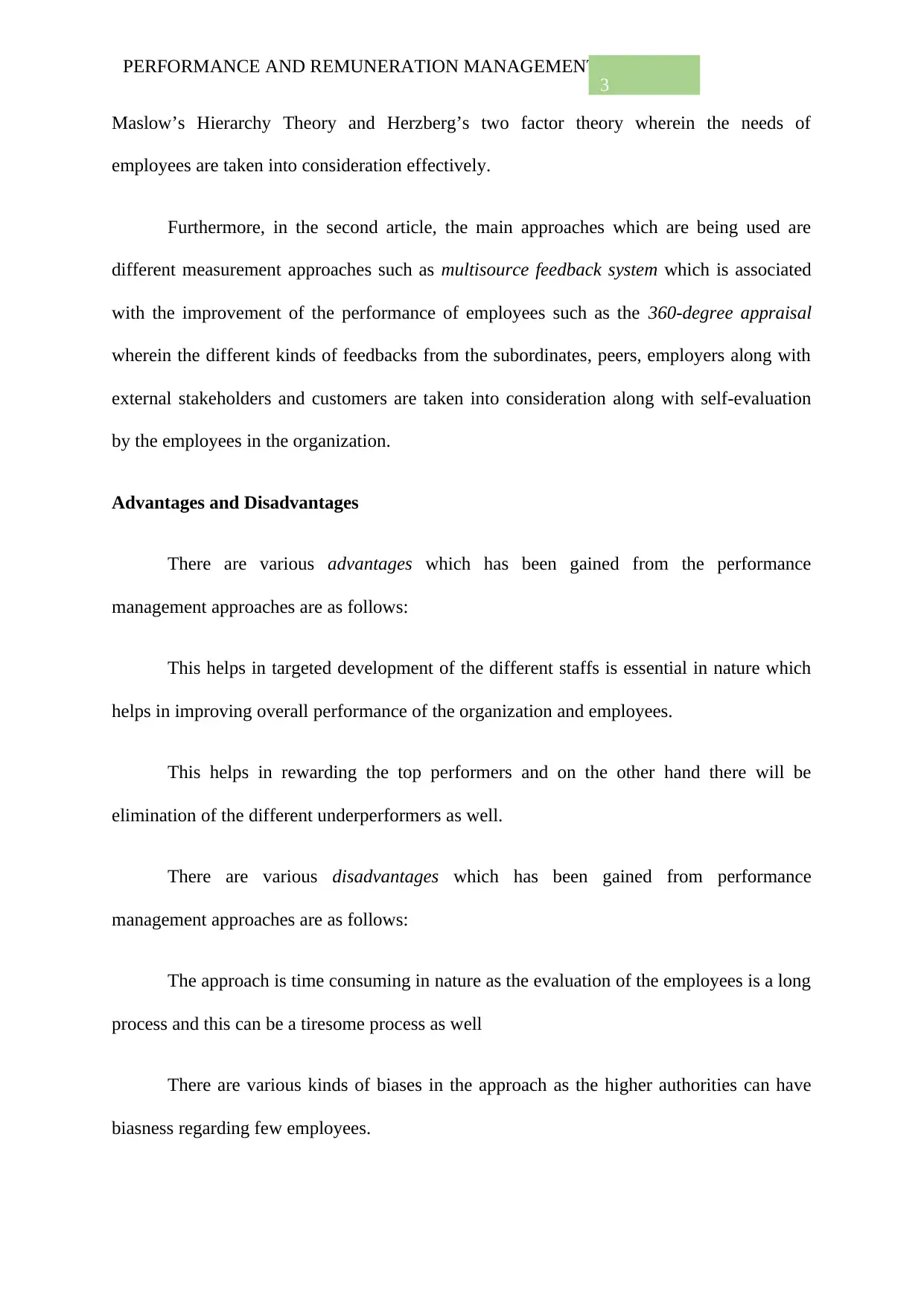
PERFORMANCE AND REMUNERATION MANAGEMENT 3
Maslow’s Hierarchy Theory and Herzberg’s two factor theory wherein the needs of
employees are taken into consideration effectively.
Furthermore, in the second article, the main approaches which are being used are
different measurement approaches such as multisource feedback system which is associated
with the improvement of the performance of employees such as the 360-degree appraisal
wherein the different kinds of feedbacks from the subordinates, peers, employers along with
external stakeholders and customers are taken into consideration along with self-evaluation
by the employees in the organization.
Advantages and Disadvantages
There are various advantages which has been gained from the performance
management approaches are as follows:
This helps in targeted development of the different staffs is essential in nature which
helps in improving overall performance of the organization and employees.
This helps in rewarding the top performers and on the other hand there will be
elimination of the different underperformers as well.
There are various disadvantages which has been gained from performance
management approaches are as follows:
The approach is time consuming in nature as the evaluation of the employees is a long
process and this can be a tiresome process as well
There are various kinds of biases in the approach as the higher authorities can have
biasness regarding few employees.
Maslow’s Hierarchy Theory and Herzberg’s two factor theory wherein the needs of
employees are taken into consideration effectively.
Furthermore, in the second article, the main approaches which are being used are
different measurement approaches such as multisource feedback system which is associated
with the improvement of the performance of employees such as the 360-degree appraisal
wherein the different kinds of feedbacks from the subordinates, peers, employers along with
external stakeholders and customers are taken into consideration along with self-evaluation
by the employees in the organization.
Advantages and Disadvantages
There are various advantages which has been gained from the performance
management approaches are as follows:
This helps in targeted development of the different staffs is essential in nature which
helps in improving overall performance of the organization and employees.
This helps in rewarding the top performers and on the other hand there will be
elimination of the different underperformers as well.
There are various disadvantages which has been gained from performance
management approaches are as follows:
The approach is time consuming in nature as the evaluation of the employees is a long
process and this can be a tiresome process as well
There are various kinds of biases in the approach as the higher authorities can have
biasness regarding few employees.
Paraphrase This Document
Need a fresh take? Get an instant paraphrase of this document with our AI Paraphraser
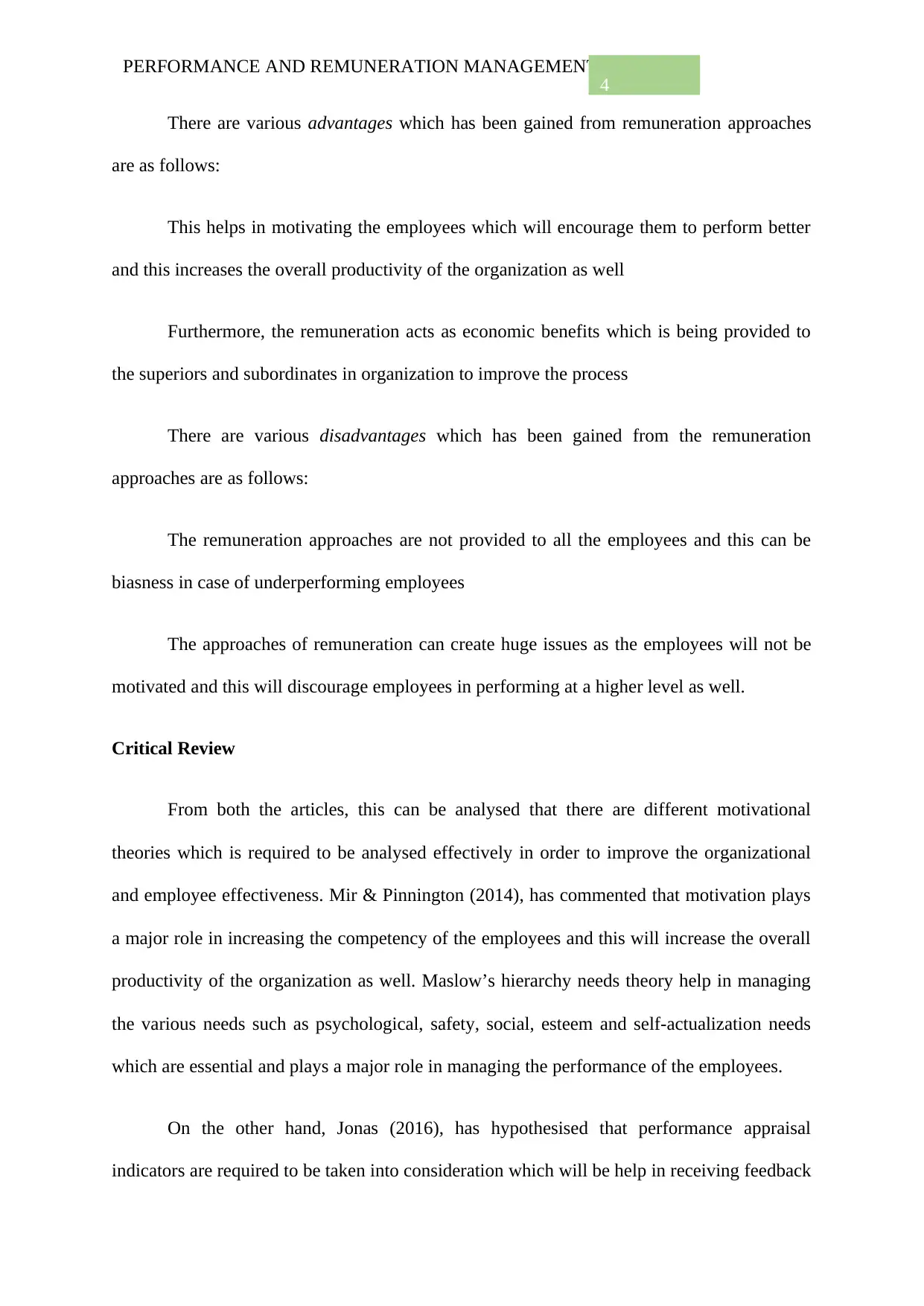
PERFORMANCE AND REMUNERATION MANAGEMENT 4
There are various advantages which has been gained from remuneration approaches
are as follows:
This helps in motivating the employees which will encourage them to perform better
and this increases the overall productivity of the organization as well
Furthermore, the remuneration acts as economic benefits which is being provided to
the superiors and subordinates in organization to improve the process
There are various disadvantages which has been gained from the remuneration
approaches are as follows:
The remuneration approaches are not provided to all the employees and this can be
biasness in case of underperforming employees
The approaches of remuneration can create huge issues as the employees will not be
motivated and this will discourage employees in performing at a higher level as well.
Critical Review
From both the articles, this can be analysed that there are different motivational
theories which is required to be analysed effectively in order to improve the organizational
and employee effectiveness. Mir & Pinnington (2014), has commented that motivation plays
a major role in increasing the competency of the employees and this will increase the overall
productivity of the organization as well. Maslow’s hierarchy needs theory help in managing
the various needs such as psychological, safety, social, esteem and self-actualization needs
which are essential and plays a major role in managing the performance of the employees.
On the other hand, Jonas (2016), has hypothesised that performance appraisal
indicators are required to be taken into consideration which will be help in receiving feedback
There are various advantages which has been gained from remuneration approaches
are as follows:
This helps in motivating the employees which will encourage them to perform better
and this increases the overall productivity of the organization as well
Furthermore, the remuneration acts as economic benefits which is being provided to
the superiors and subordinates in organization to improve the process
There are various disadvantages which has been gained from the remuneration
approaches are as follows:
The remuneration approaches are not provided to all the employees and this can be
biasness in case of underperforming employees
The approaches of remuneration can create huge issues as the employees will not be
motivated and this will discourage employees in performing at a higher level as well.
Critical Review
From both the articles, this can be analysed that there are different motivational
theories which is required to be analysed effectively in order to improve the organizational
and employee effectiveness. Mir & Pinnington (2014), has commented that motivation plays
a major role in increasing the competency of the employees and this will increase the overall
productivity of the organization as well. Maslow’s hierarchy needs theory help in managing
the various needs such as psychological, safety, social, esteem and self-actualization needs
which are essential and plays a major role in managing the performance of the employees.
On the other hand, Jonas (2016), has hypothesised that performance appraisal
indicators are required to be taken into consideration which will be help in receiving feedback
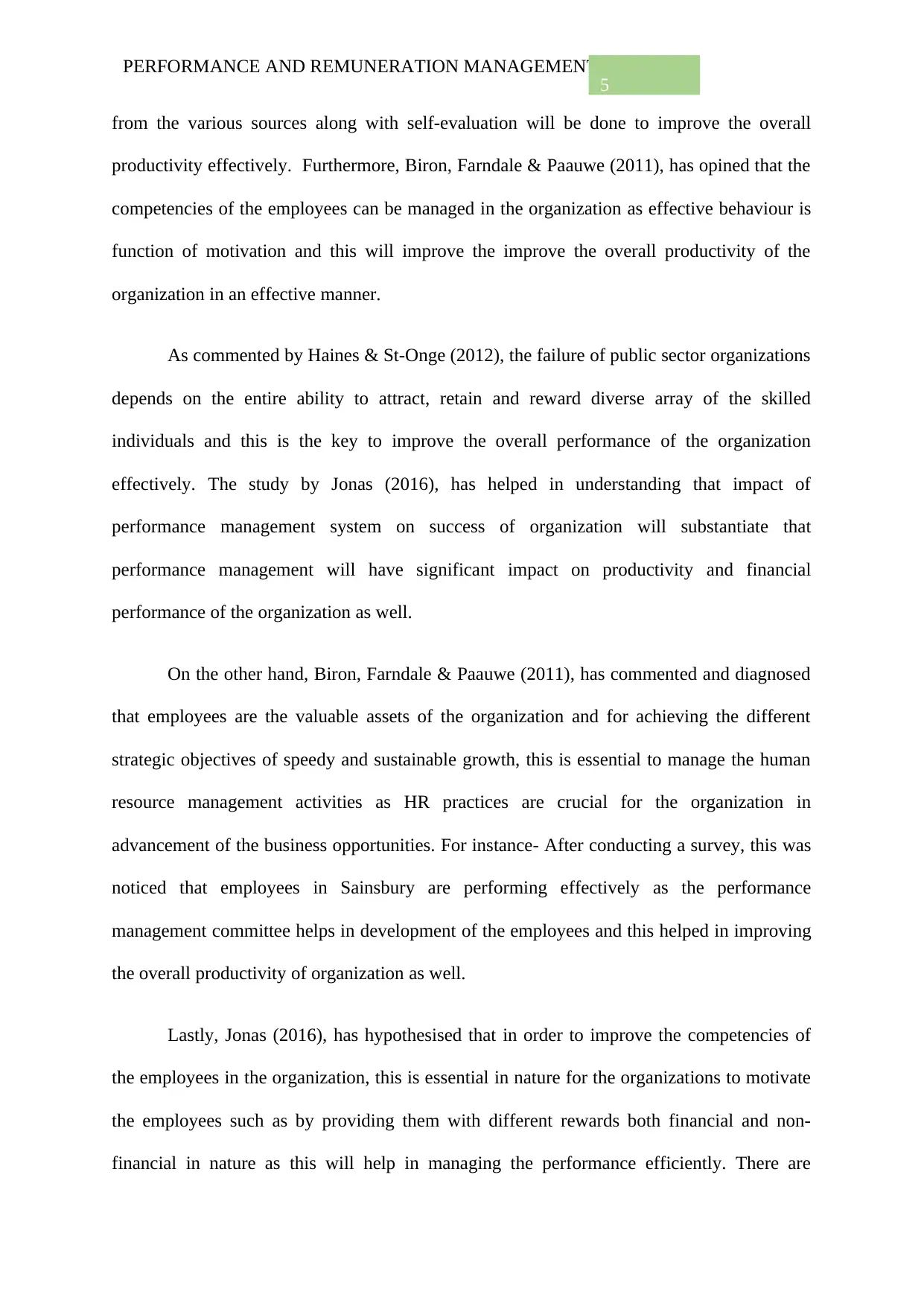
PERFORMANCE AND REMUNERATION MANAGEMENT 5
from the various sources along with self-evaluation will be done to improve the overall
productivity effectively. Furthermore, Biron, Farndale & Paauwe (2011), has opined that the
competencies of the employees can be managed in the organization as effective behaviour is
function of motivation and this will improve the improve the overall productivity of the
organization in an effective manner.
As commented by Haines & St-Onge (2012), the failure of public sector organizations
depends on the entire ability to attract, retain and reward diverse array of the skilled
individuals and this is the key to improve the overall performance of the organization
effectively. The study by Jonas (2016), has helped in understanding that impact of
performance management system on success of organization will substantiate that
performance management will have significant impact on productivity and financial
performance of the organization as well.
On the other hand, Biron, Farndale & Paauwe (2011), has commented and diagnosed
that employees are the valuable assets of the organization and for achieving the different
strategic objectives of speedy and sustainable growth, this is essential to manage the human
resource management activities as HR practices are crucial for the organization in
advancement of the business opportunities. For instance- After conducting a survey, this was
noticed that employees in Sainsbury are performing effectively as the performance
management committee helps in development of the employees and this helped in improving
the overall productivity of organization as well.
Lastly, Jonas (2016), has hypothesised that in order to improve the competencies of
the employees in the organization, this is essential in nature for the organizations to motivate
the employees such as by providing them with different rewards both financial and non-
financial in nature as this will help in managing the performance efficiently. There are
from the various sources along with self-evaluation will be done to improve the overall
productivity effectively. Furthermore, Biron, Farndale & Paauwe (2011), has opined that the
competencies of the employees can be managed in the organization as effective behaviour is
function of motivation and this will improve the improve the overall productivity of the
organization in an effective manner.
As commented by Haines & St-Onge (2012), the failure of public sector organizations
depends on the entire ability to attract, retain and reward diverse array of the skilled
individuals and this is the key to improve the overall performance of the organization
effectively. The study by Jonas (2016), has helped in understanding that impact of
performance management system on success of organization will substantiate that
performance management will have significant impact on productivity and financial
performance of the organization as well.
On the other hand, Biron, Farndale & Paauwe (2011), has commented and diagnosed
that employees are the valuable assets of the organization and for achieving the different
strategic objectives of speedy and sustainable growth, this is essential to manage the human
resource management activities as HR practices are crucial for the organization in
advancement of the business opportunities. For instance- After conducting a survey, this was
noticed that employees in Sainsbury are performing effectively as the performance
management committee helps in development of the employees and this helped in improving
the overall productivity of organization as well.
Lastly, Jonas (2016), has hypothesised that in order to improve the competencies of
the employees in the organization, this is essential in nature for the organizations to motivate
the employees such as by providing them with different rewards both financial and non-
financial in nature as this will help in managing the performance efficiently. There are
⊘ This is a preview!⊘
Do you want full access?
Subscribe today to unlock all pages.

Trusted by 1+ million students worldwide
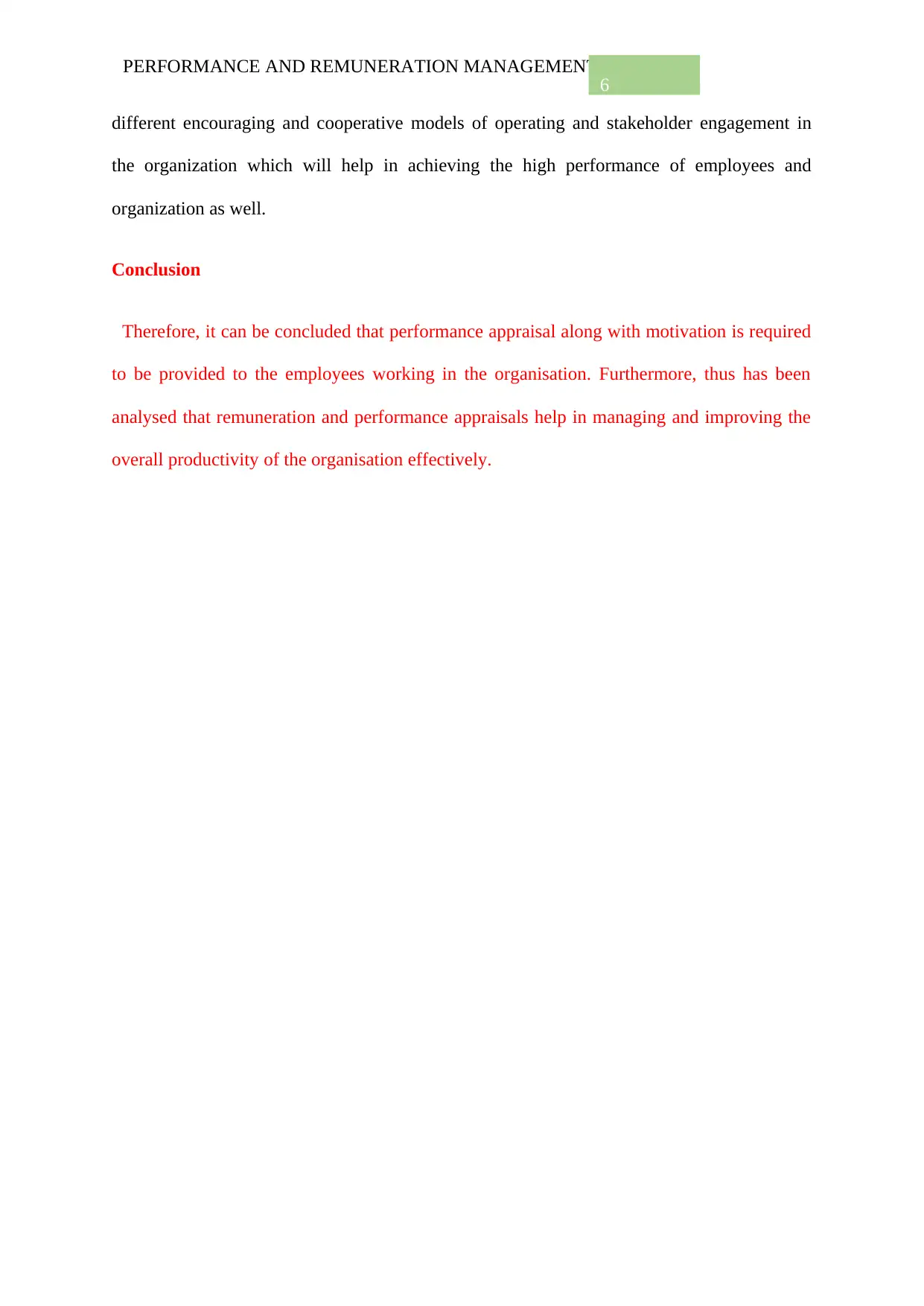
PERFORMANCE AND REMUNERATION MANAGEMENT 6
different encouraging and cooperative models of operating and stakeholder engagement in
the organization which will help in achieving the high performance of employees and
organization as well.
Conclusion
Therefore, it can be concluded that performance appraisal along with motivation is required
to be provided to the employees working in the organisation. Furthermore, thus has been
analysed that remuneration and performance appraisals help in managing and improving the
overall productivity of the organisation effectively.
different encouraging and cooperative models of operating and stakeholder engagement in
the organization which will help in achieving the high performance of employees and
organization as well.
Conclusion
Therefore, it can be concluded that performance appraisal along with motivation is required
to be provided to the employees working in the organisation. Furthermore, thus has been
analysed that remuneration and performance appraisals help in managing and improving the
overall productivity of the organisation effectively.
Paraphrase This Document
Need a fresh take? Get an instant paraphrase of this document with our AI Paraphraser
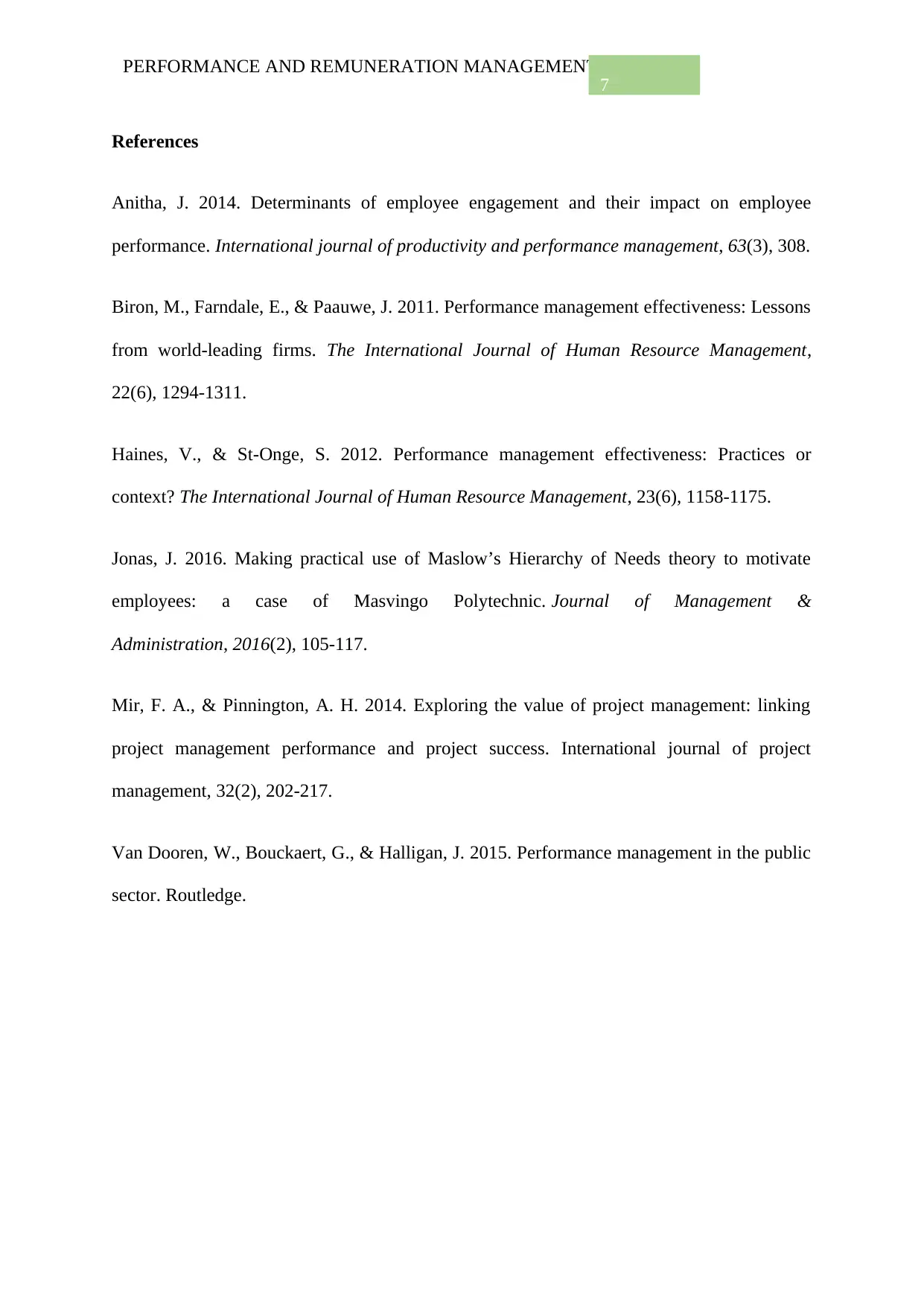
PERFORMANCE AND REMUNERATION MANAGEMENT 7
References
Anitha, J. 2014. Determinants of employee engagement and their impact on employee
performance. International journal of productivity and performance management, 63(3), 308.
Biron, M., Farndale, E., & Paauwe, J. 2011. Performance management effectiveness: Lessons
from world-leading firms. The International Journal of Human Resource Management,
22(6), 1294-1311.
Haines, V., & St-Onge, S. 2012. Performance management effectiveness: Practices or
context? The International Journal of Human Resource Management, 23(6), 1158-1175.
Jonas, J. 2016. Making practical use of Maslow’s Hierarchy of Needs theory to motivate
employees: a case of Masvingo Polytechnic. Journal of Management &
Administration, 2016(2), 105-117.
Mir, F. A., & Pinnington, A. H. 2014. Exploring the value of project management: linking
project management performance and project success. International journal of project
management, 32(2), 202-217.
Van Dooren, W., Bouckaert, G., & Halligan, J. 2015. Performance management in the public
sector. Routledge.
References
Anitha, J. 2014. Determinants of employee engagement and their impact on employee
performance. International journal of productivity and performance management, 63(3), 308.
Biron, M., Farndale, E., & Paauwe, J. 2011. Performance management effectiveness: Lessons
from world-leading firms. The International Journal of Human Resource Management,
22(6), 1294-1311.
Haines, V., & St-Onge, S. 2012. Performance management effectiveness: Practices or
context? The International Journal of Human Resource Management, 23(6), 1158-1175.
Jonas, J. 2016. Making practical use of Maslow’s Hierarchy of Needs theory to motivate
employees: a case of Masvingo Polytechnic. Journal of Management &
Administration, 2016(2), 105-117.
Mir, F. A., & Pinnington, A. H. 2014. Exploring the value of project management: linking
project management performance and project success. International journal of project
management, 32(2), 202-217.
Van Dooren, W., Bouckaert, G., & Halligan, J. 2015. Performance management in the public
sector. Routledge.
1 out of 8
Related Documents
Your All-in-One AI-Powered Toolkit for Academic Success.
+13062052269
info@desklib.com
Available 24*7 on WhatsApp / Email
![[object Object]](/_next/static/media/star-bottom.7253800d.svg)
Unlock your academic potential
Copyright © 2020–2025 A2Z Services. All Rights Reserved. Developed and managed by ZUCOL.





